Geochemical and Petrographical Characteristics of the Madzaringwe Formation Coal, Mudrocks and Sandstones in the Vele Colliery, Limpopo Province, South Africa: Implications for Tectonic Setting, Provenance and Paleoweathering
Abstract
:1. Introduction
2. Geological Setting
3. Materials and Methods
4. Results
4.1. Stratigraphy
4.2. Petrography and Mineralogy
4.3. Geochemistry
5. Interpretation and Discussion
5.1. Tectonic Setting
5.2. Source Area (Provenance)
5.3. Paleoweathering Conditions
6. Conclusions
Supplementary Materials
Author Contributions
Funding
Institutional Review Board Statement
Informed Consent Statement
Data Availability Statement
Acknowledgments
Conflicts of Interest
References
- Bordy, E.M. Sedimentology of the Karoo Supergroup in the Tuli Basin. Ph.D. Thesis, Rhodes University, Makhanda, Eastern Cape, South Africa, 2000; pp. 124–168. [Google Scholar]
- Hancox, P.J.; Götz, A.E. South Africa’s coalfields-A 2014 perspective. Int. J. Coal Geol. 2014, 132, 170–254. [Google Scholar] [CrossRef] [Green Version]
- Nesbitt, H.W.; Young, G.M. Early Proterozoic climates and plate motions inferred from major element chemistry of lutites. Nature 1982, 299, 715–717. [Google Scholar] [CrossRef]
- Raza, M.; Dayal, A.M.; Khan, A.; Bhardwaj, V.R.; Rais, S. Geochemistry of lower Vindhyan clastic sedimentary rocks of North-western Indian shield: Implications for composition and weathering history of Proterozoic continental crust. J. Asian Earth Sci. 2010, 39, 51–61. [Google Scholar] [CrossRef]
- Taylor, S.R.; McLennan, S.M. The Continental Crust: Its Composition and Evolution; Blackwell Scientific Publications: Boston, MA, USA, 1985; pp. 275–293. [Google Scholar]
- Bhatia, M.R.; Crook, K.A.W. Trace element characteristics of greywacke and tectonic setting discrimination of sedimentary basins. Contrib. Mineral. Petrol. 1986, 92, 181–193. [Google Scholar] [CrossRef]
- McLennan, S.M.; Hemming, S.; McDaniel, D.K.; Hanson, G.N. Geochemical approaches to sedimentation, provenance and tectonics. In Processes Controlling the Composition of Clastic Sediments. Geological Society of American Special Paper; Johnson, M.J., Basu, A., Eds.; Geological Society of America: Boulder, CO, USA, 1993; pp. 21–40. [Google Scholar]
- Wronkiewicz, D.J.; Condie, K.C. Geochemistry and mineralogy of sediments from the Ventersdorp and Transvaal Supergroups, South Africa: Cratonic evolution during the early Proterozoic. Geochim. Cosmochim. Acta 1990, 54, 343–354. [Google Scholar] [CrossRef]
- Malaza, N.; Liu, K.; Zhao, B. Facies Analysis and Depositional Environments of the Late Palaeozoic Coal-Bearing Madzaringwe Formation in the Tshipise-Pafuri Basin, South Africa. Int. Sch. Res. Not. Geol. 2013, 2013, 1–11. [Google Scholar] [CrossRef] [Green Version]
- Brandl, G. The Geology of the Alldays Area. Explanation Sheet Geological Survey South Africa, 2228 (Alldays); Council for Geoscience: Pretoria, South Africa, 2002; pp. 32–71. [Google Scholar]
- Brandl, G.; McCourt, S. A lithostratigraphic subdivision of the Karoo Sequence in the north-eastern Transvaal. Ann. Geol. Surv. South Afr. 1980, 14, 51–56. [Google Scholar]
- Brandl, G. The Geology of the Messina Area. Explanation Sheet Geological Survey South Africa, 2230 (Messina); Council for Geoscience: Pretoria, South Africa, 1981; pp. 1–35. [Google Scholar]
- Johnson, M.R.; Van Vuuren, C.J.; Hegenberger, W.F.; Key, R.; Show, U. Stratigraphy of the Karoo Supergroup in southern Africa: An overview. J. Afr. Earth Sci. 1996, 23, 3–15. [Google Scholar] [CrossRef]
- Baiyegunhi, C.; Liu, K.; Gwavava, O. Geochemistry of sandstones and shales from the Ecca Group, Karoo Supergroup, in the Eastern Cape Province of South Africa: Implications for provenance, weathering and tectonic setting. Open Geosci. 2017, 9, 340–360. [Google Scholar] [CrossRef] [Green Version]
- Akinlua, A.; Sigedle, A.; Buthelezi, T.; Fadipe, O.A. Trace element geochemistry of crude oils and condensates from South African Basins. Mar. Pet. Geol. 2015, 59, 286–293. [Google Scholar] [CrossRef]
- Bordy, E.M.; Catuneanu, O. Sedimentology and palaeontology of upper Karoo aeolian strata (Early Jurassic) in the Tuli Basin, South Africa. J. Afr. Earth Sci. 2002, 35, 301–314. [Google Scholar] [CrossRef]
- Barton, J.M.; Key, R.M. The Tectonic Development of the Limpopo Mobile belt and the Evolution of the Archaean Cratons of Southern Africa. Dev. Precambrian Geol. 1981, 4, 185–212. [Google Scholar]
- Luyt, J.P. The Tectono-Sedimentary History of the Coal-Bearing Tshipise Karoo Basin. Ph.D. Thesis, University of Pretoria, Hatfield, South Africa, 2017; pp. 146–179. [Google Scholar]
- Malaza, N.; Liu, K.; Zhao, B. Subsidence Analysis and Burial History of the Late Carboniferous to Early Jurassic Soutpansberg Basin, Limpopo Province, South Africa. Acta Geol. Sin. Engl. Ed. 2016, 90, 2411–2426. [Google Scholar] [CrossRef]
- Van der Merwe, W.C.; Flint, S.S.; Hodgson, D.M. Sequence stratigraphy of an argillaceous, deepwater basin-plain succession: Vischkuil Formation (Permian), Karoo Basin, South Africa. Mar. Pet. Geol. 2010, 27, 321–333. [Google Scholar] [CrossRef]
- Pettijohn, F.J. Sedimentary Rocks, 3rd ed.; Harper and Row: New York, NY, USA, 1975; pp. 431–468. [Google Scholar]
- Turekan, K.K.; Wedephol, K.H. Distribution of the elements in some major units of the Earth’s crust. Geol. Soc. Am. Bull. 1961, 72, 175–191. [Google Scholar] [CrossRef]
- Vine, J.D.; Tourtelot, E.B. Geochemistry of black shale deposits-a summary report. Econ. Geol. 1970, 65, 253–272. [Google Scholar] [CrossRef]
- Levinson, A.A. Introduction to Exploration Geochemistry; Applied Publishing: Wilmette, IL, USA, 1974; pp. 1–34. [Google Scholar]
- Gromet, L.P.; Dymek, R.F.; Haskin, L.A.; Korotev, R.L. The North American shale composite. Its compilation, major and trace element characteristics. Geochim. Cosmochim. Acta 1984, 48, 2469–2482. [Google Scholar] [CrossRef]
- Rudnick, R.L.; Gao, S. Composition of the continental crust. Treatise Geochem. 2003, 3, 1–64. [Google Scholar]
- Bhatia, M.R. Plate tectonics and geochemical composition of sandstones. J. Geol. 1983, 91, 611–627. [Google Scholar] [CrossRef]
- Roser, B.P.; Korsch, R.J. Determination of tectonic setting of sandstone-mudstone suites using SiO2 content and K2O/Na2O ratio. J. Geol. 1986, 94, 635–650. [Google Scholar] [CrossRef]
- Toulkeridis, T.; Clauer, N.; Kröner, A.; Reimer, T.; Todt, W. Characterization, provenance, and tectonic setting of Fig Tree greywackes from the Archaean Barberton greenstone belt, South Africa. Sediment. Geol. 1999, 124, 113–129. [Google Scholar] [CrossRef]
- Roser, B.P.; Korsch, R.J. Provenance signature of sandstone mudstone suite determined using discriminant function analysis of major element data. Chem. Geol. 1988, 67, 119–139. [Google Scholar] [CrossRef]
- Armstrong-Altrin, J.S.; Lee, Y.I.; Verma, S.P.; Ramasamy, S. Geochemistry of sandstones from the Upper Miocene Kudankulam Formation, southern India: Implication for provenance, weathering and tectonic setting. J. Sediment. Res. 2004, 74, 285–297. [Google Scholar] [CrossRef]
- Zhang, L.; Sun, M.; Wang, S.; Yu, X. The composition of shales from the Ordos basin, China: Effects of source weathering and diagenesis. Sediment. Geol. 1998, 116, 129–141. [Google Scholar] [CrossRef]
- Cullers, R.L.; Basu, A.; Suttner, L. Geochemical signature of provenance in sand-size material in soils and stream sediments near the Tobacco Root batholith, Montana, USA. Chem. Geol. 1988, 70, 335–348. [Google Scholar] [CrossRef]
- Bracciali, L.; Marroni, M.; Pandolfi, L.; Rocchi, S. Geochemistry and petrography of Western Tethys Cretaceous sedimentary covers (Corsica and Northern Apennines): From source area to configuration of margins. In Sedimentary Provenance and Petrogenesis: Perspectives from Petrography and Geochemistry. Geological Society of America Special Paper; Arribas, J., Critlli, S., Johanson, M.J., Eds.; Geological Society of America: Boulder, CO, USA, 2007; Volume 420, pp. 73–93. [Google Scholar]
- Wronkiewicz, D.J.; Condie, K.C. Geochemistry of Archean shales from the Witwatersrand Supergroup, South Africa: Source-area weathering and provenance. Geochim. Cosmochim. Acta 1987, 51, 2401–2416. [Google Scholar] [CrossRef]
- Cullers, R.L.; Podkovyrov, V.L. Geochemistry of the Mesoproterozoic Lakhanda shales in south-eastern Yakutia, Russia: Implications for mineralogical and provenance control and recycling. Precambrian Res. 2000, 104, 77–93. [Google Scholar] [CrossRef]
- Piper, D.J.W.; Pe-Piper, G.; Ledger-Piercey, S. Geochemistry of the Lower Cretaceous Chaswood Formation, Nova Scotia, Canada: Provenance and diagenesis. Can. J. Earth Sci. 2008, 45, 1083–1094. [Google Scholar] [CrossRef]
- Fedo, C.M.; Nesbitt, H.W.; Young, G.M. Unravelling the effects of potassium metasomatism in sedimentary rocks and paleosols, with implications for paleoweathering conditions and provenance. Geology 1995, 23, 921–924. [Google Scholar] [CrossRef]
- Nesbitt, H.W.; Young, G.M. Prediction of some weathering trends of plutonic and volcanic rocks based upon thermodynamic and kinetic consideration. Geochim. Cosmochim. Acta 1984, 48, 1523–1534. [Google Scholar] [CrossRef]
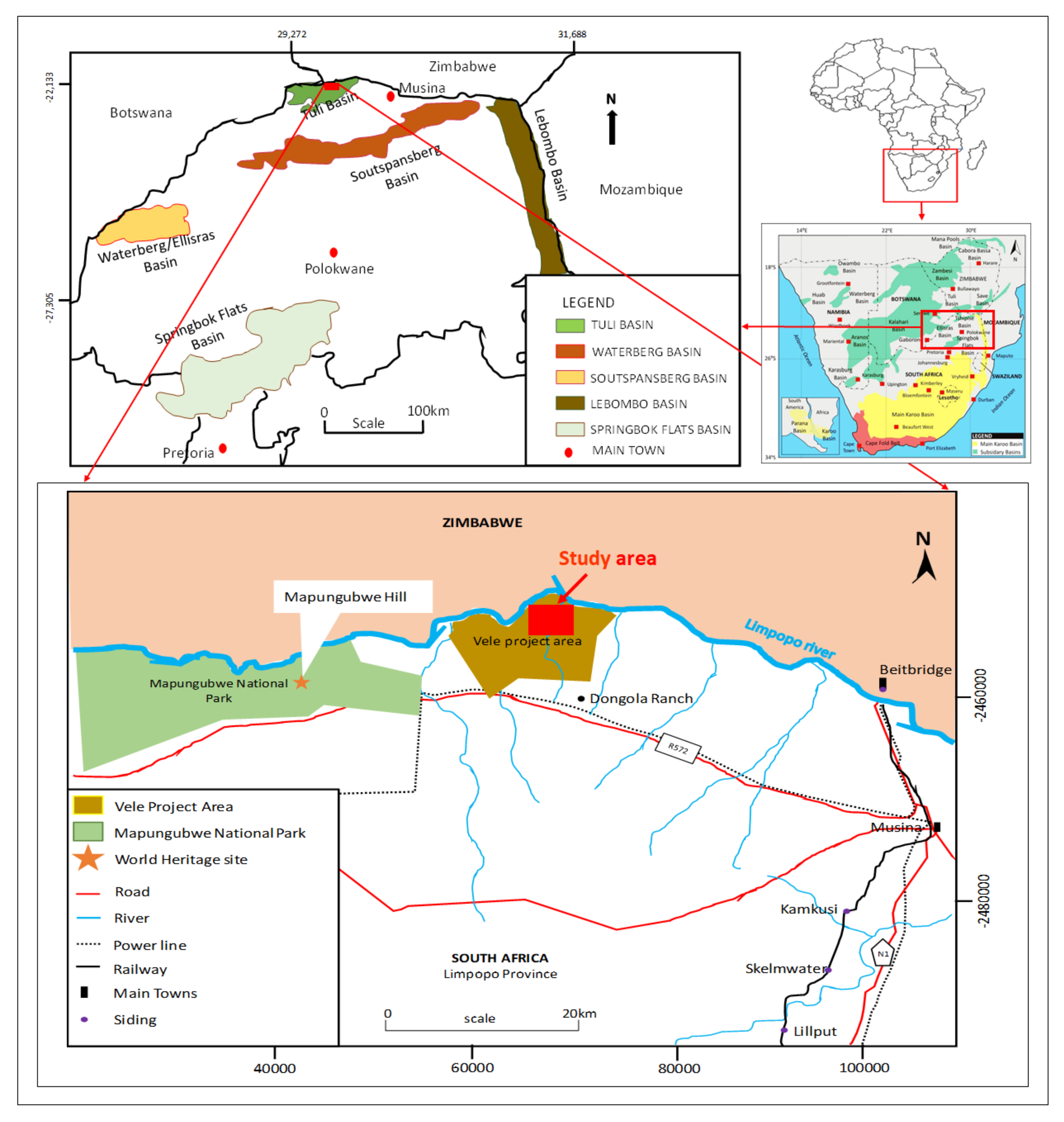

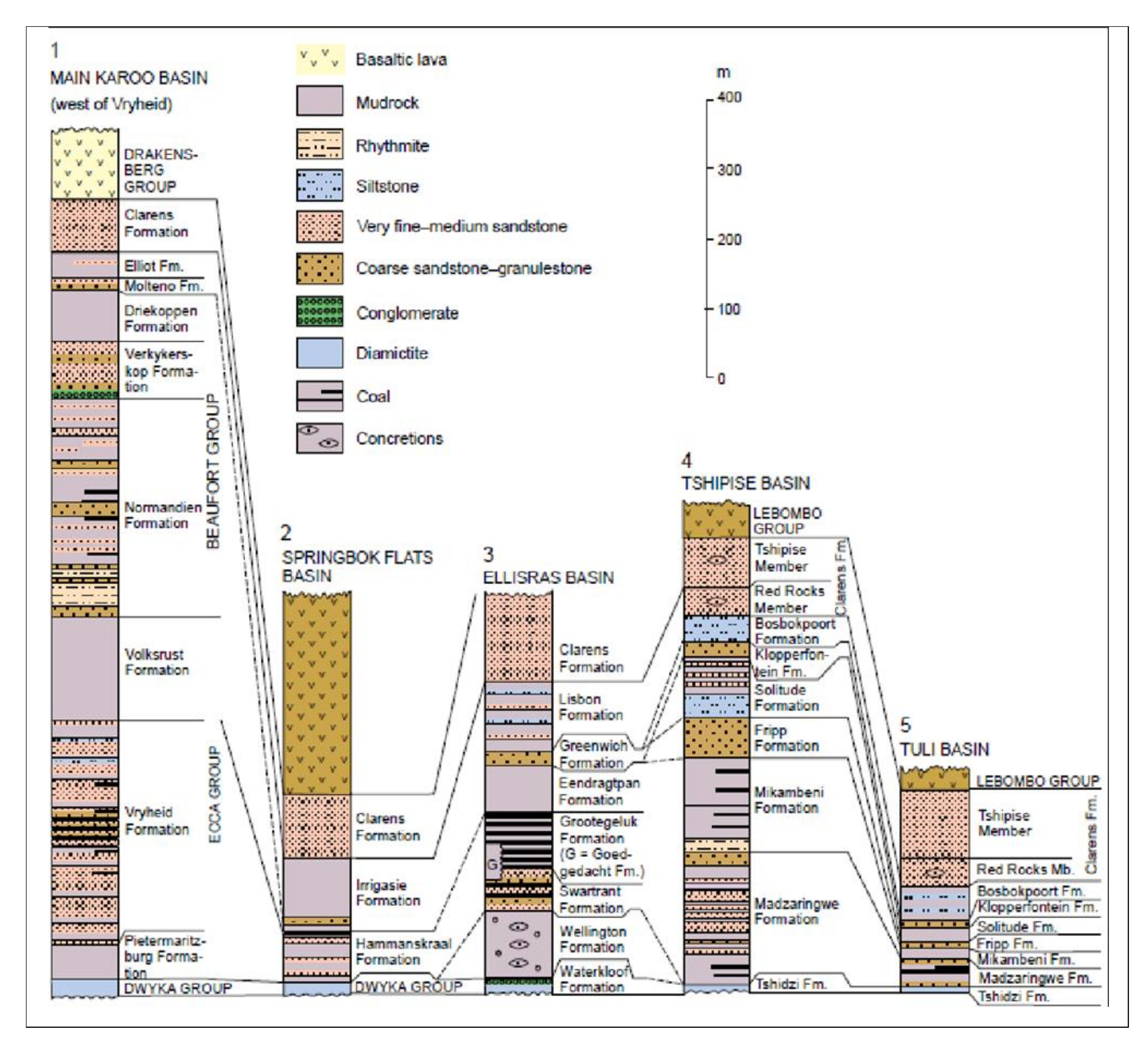
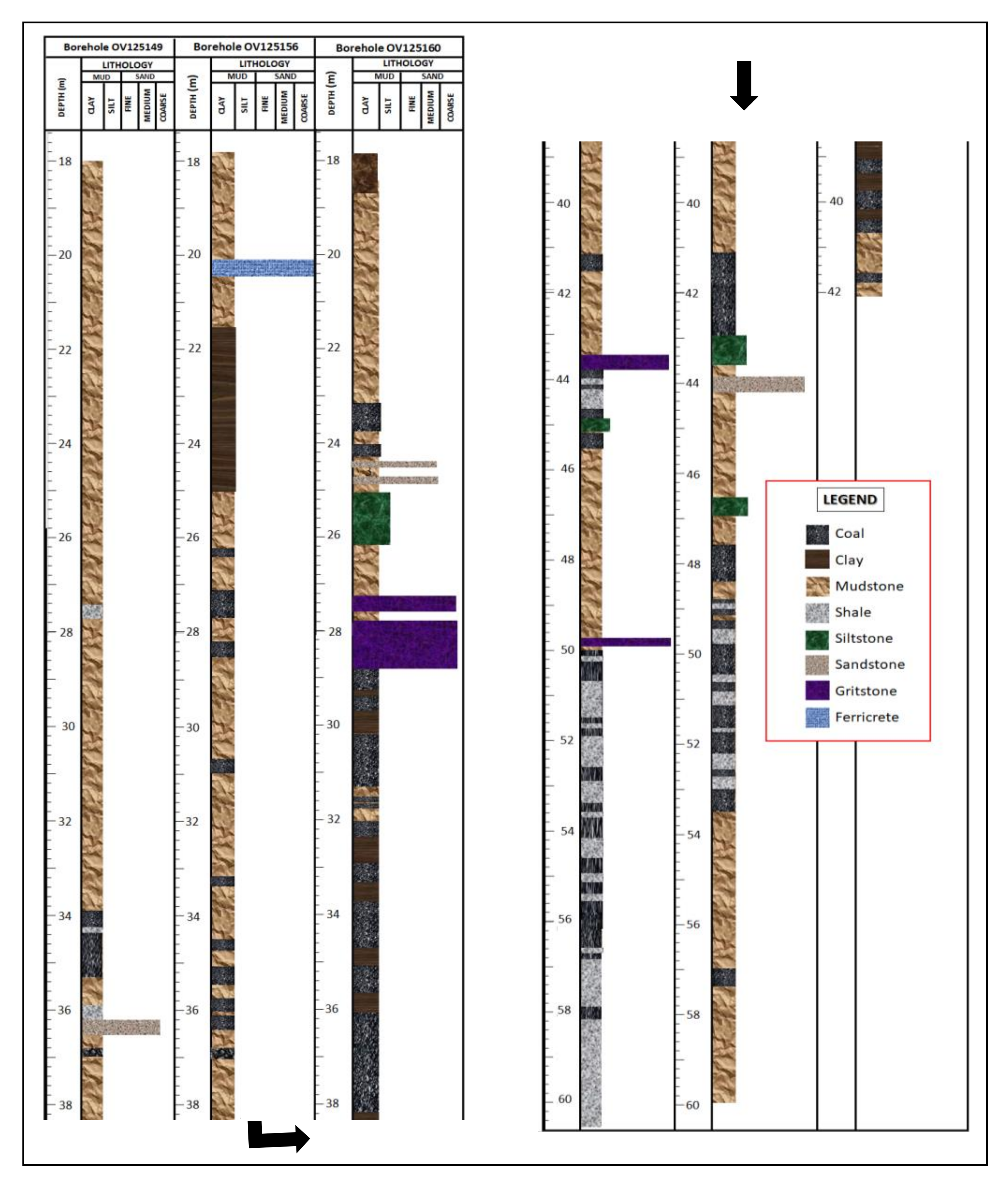
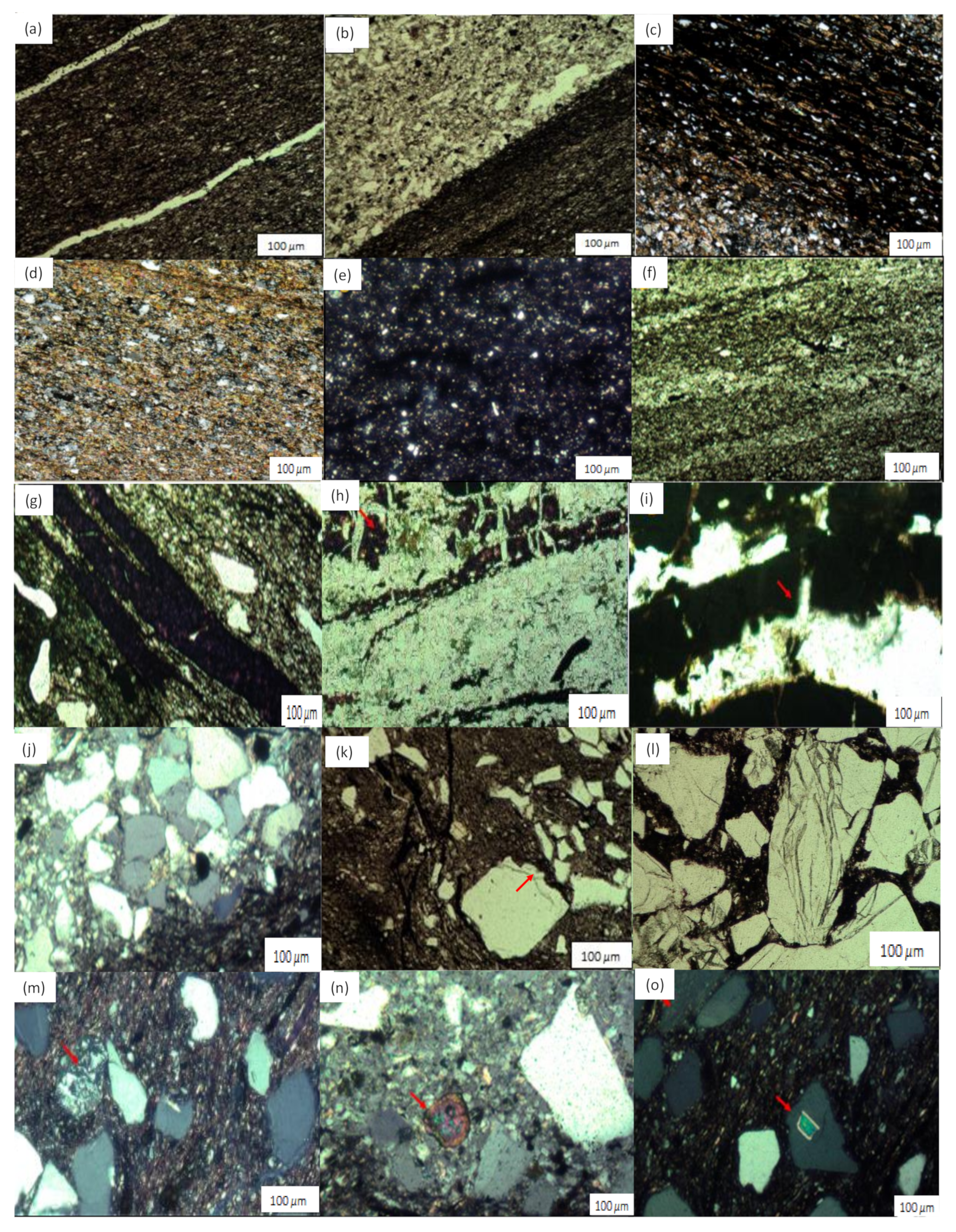
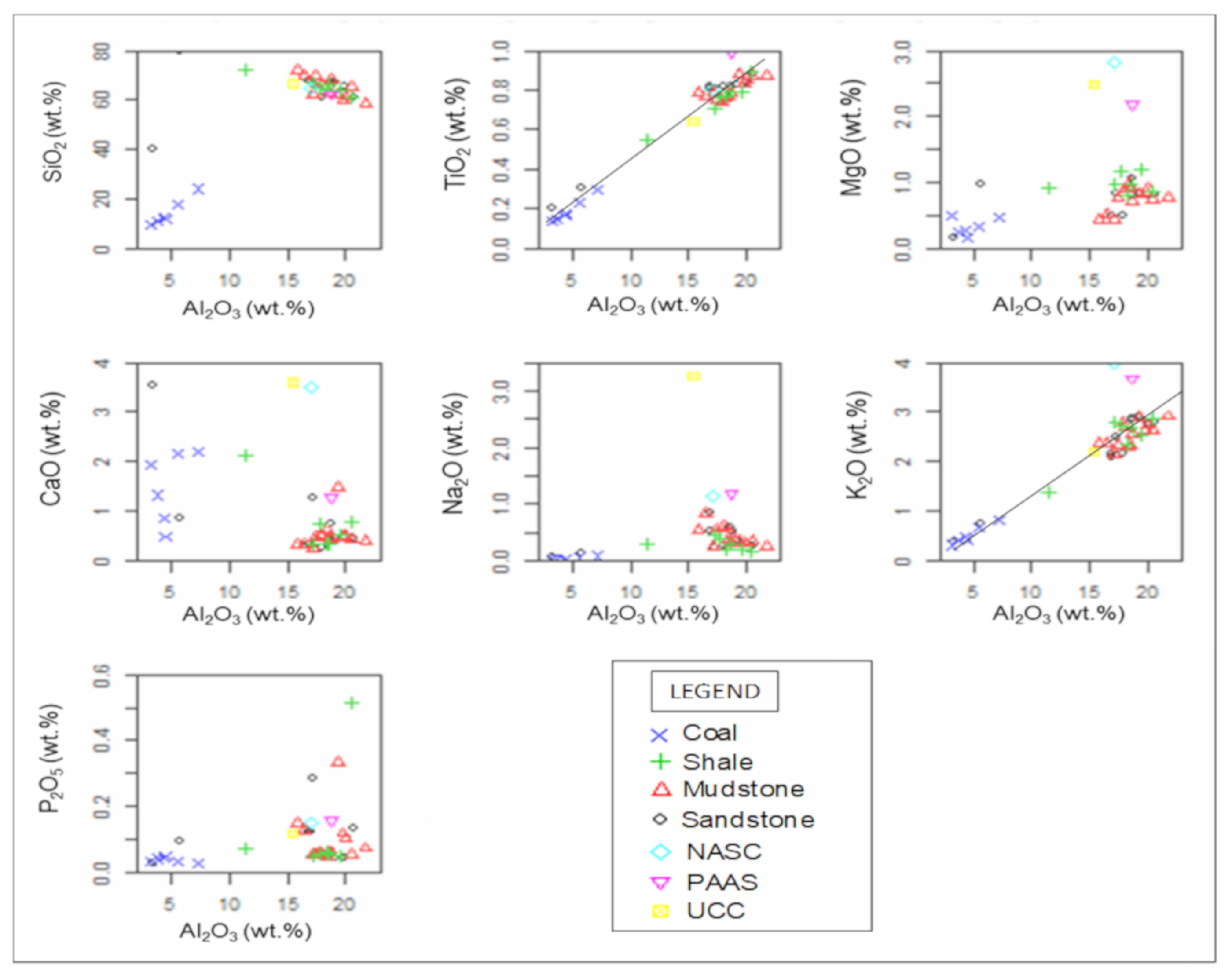
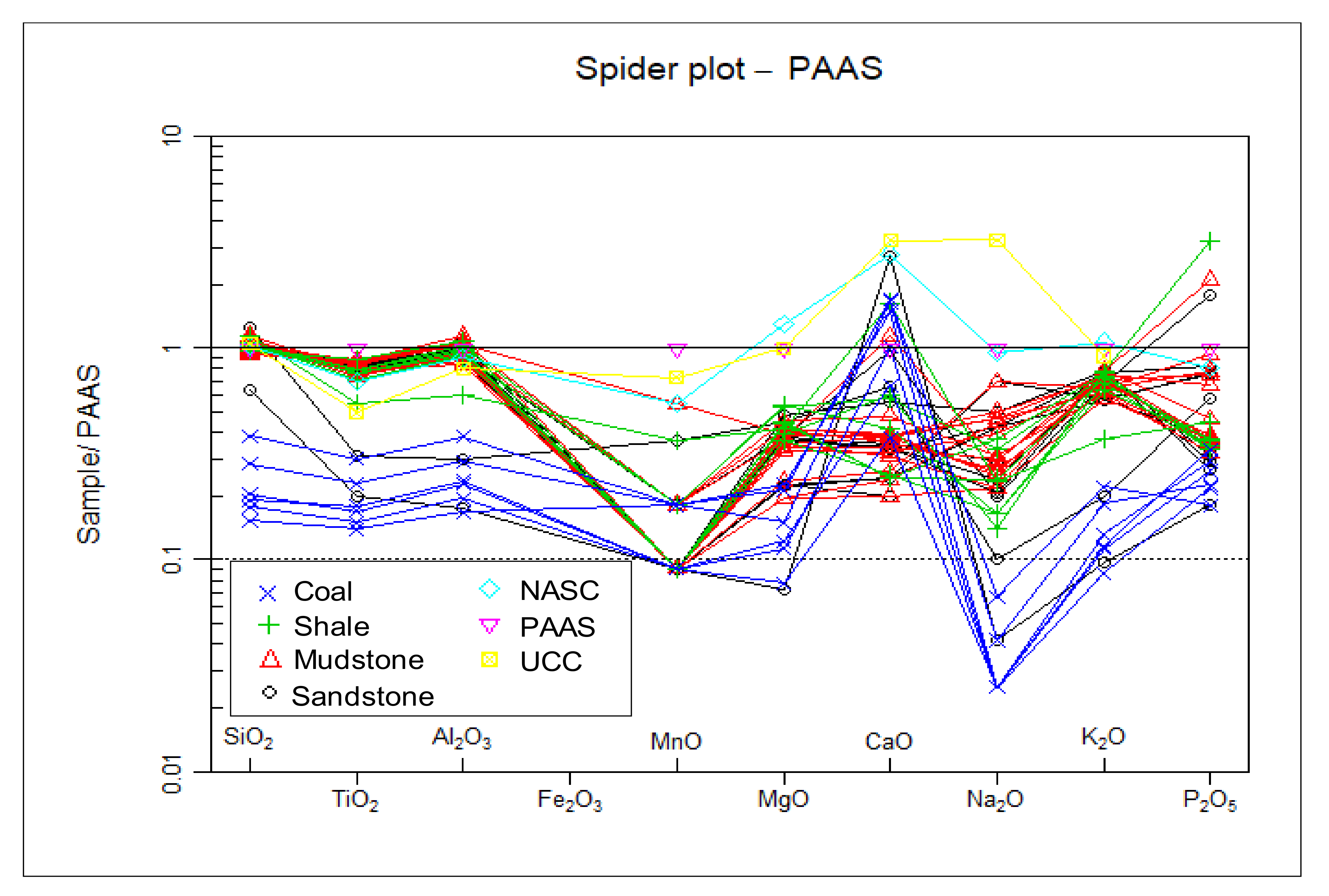
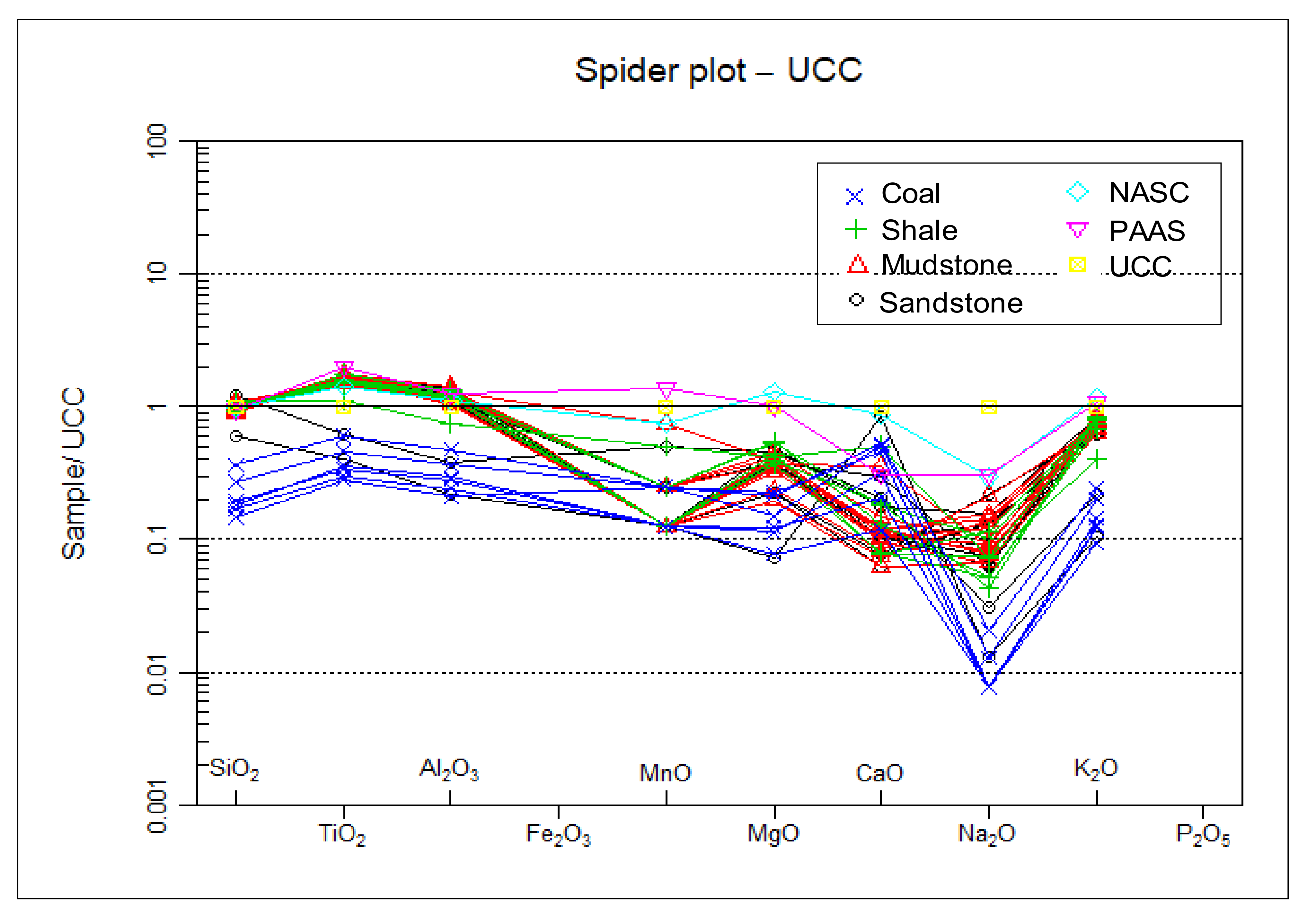
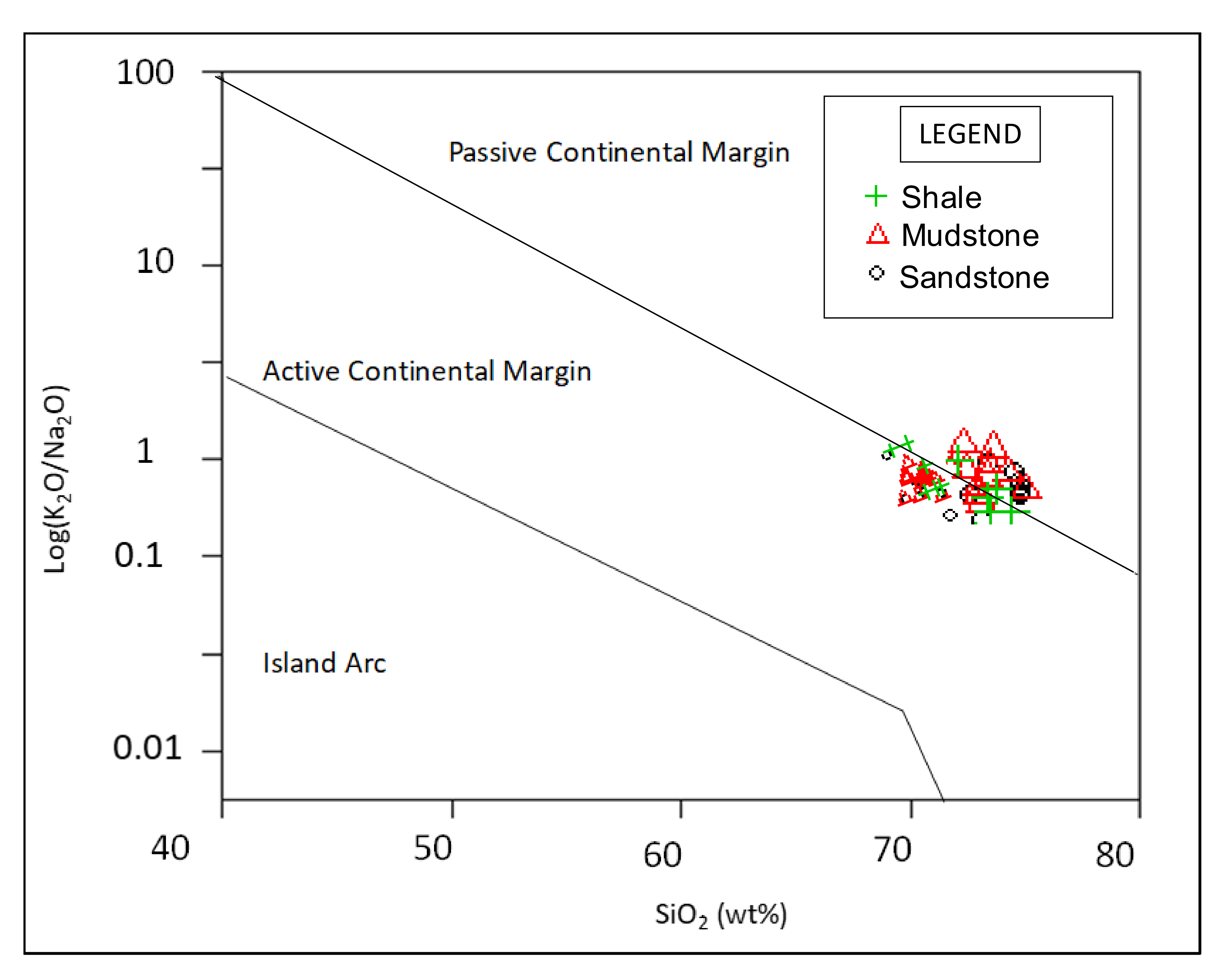
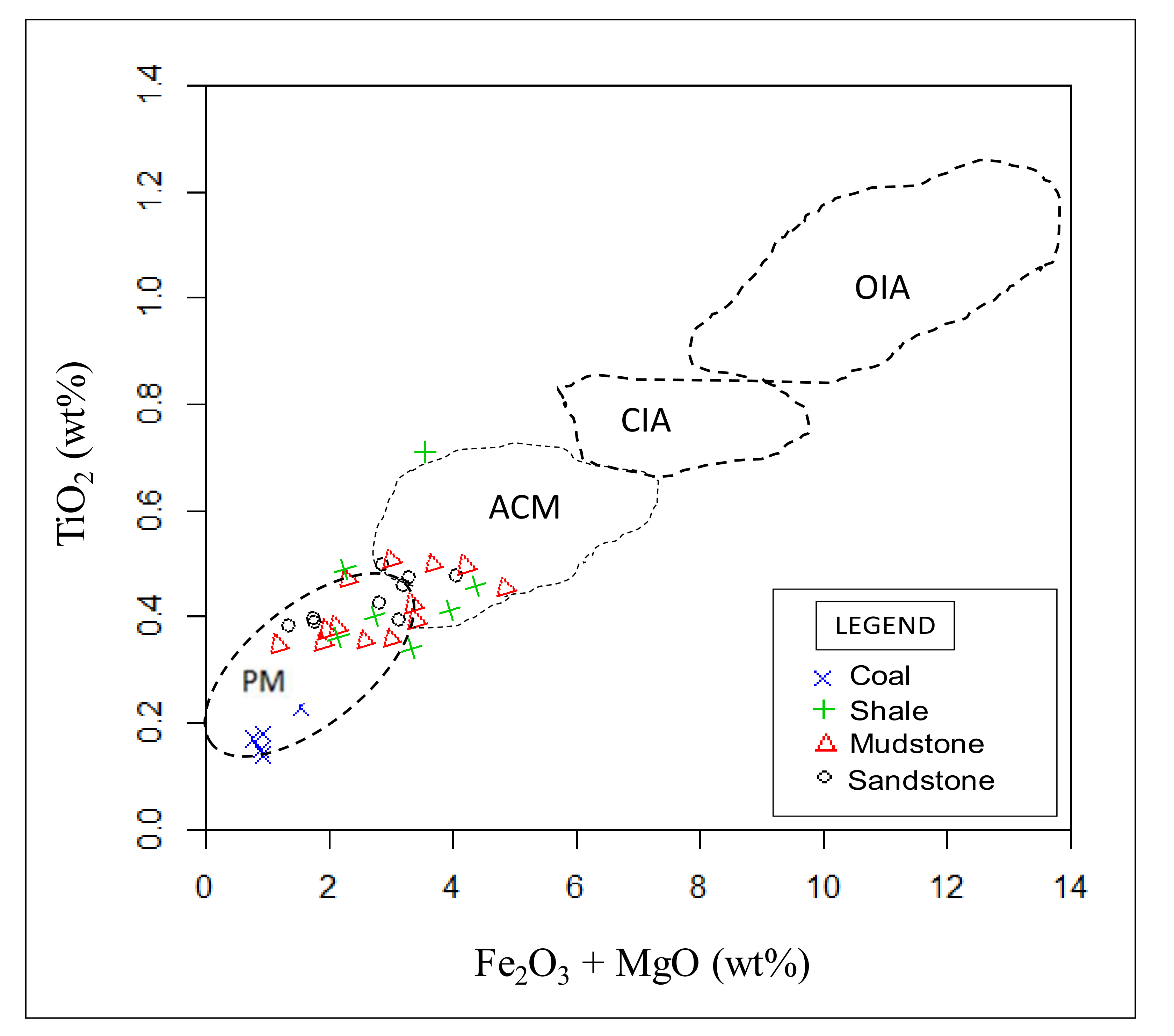
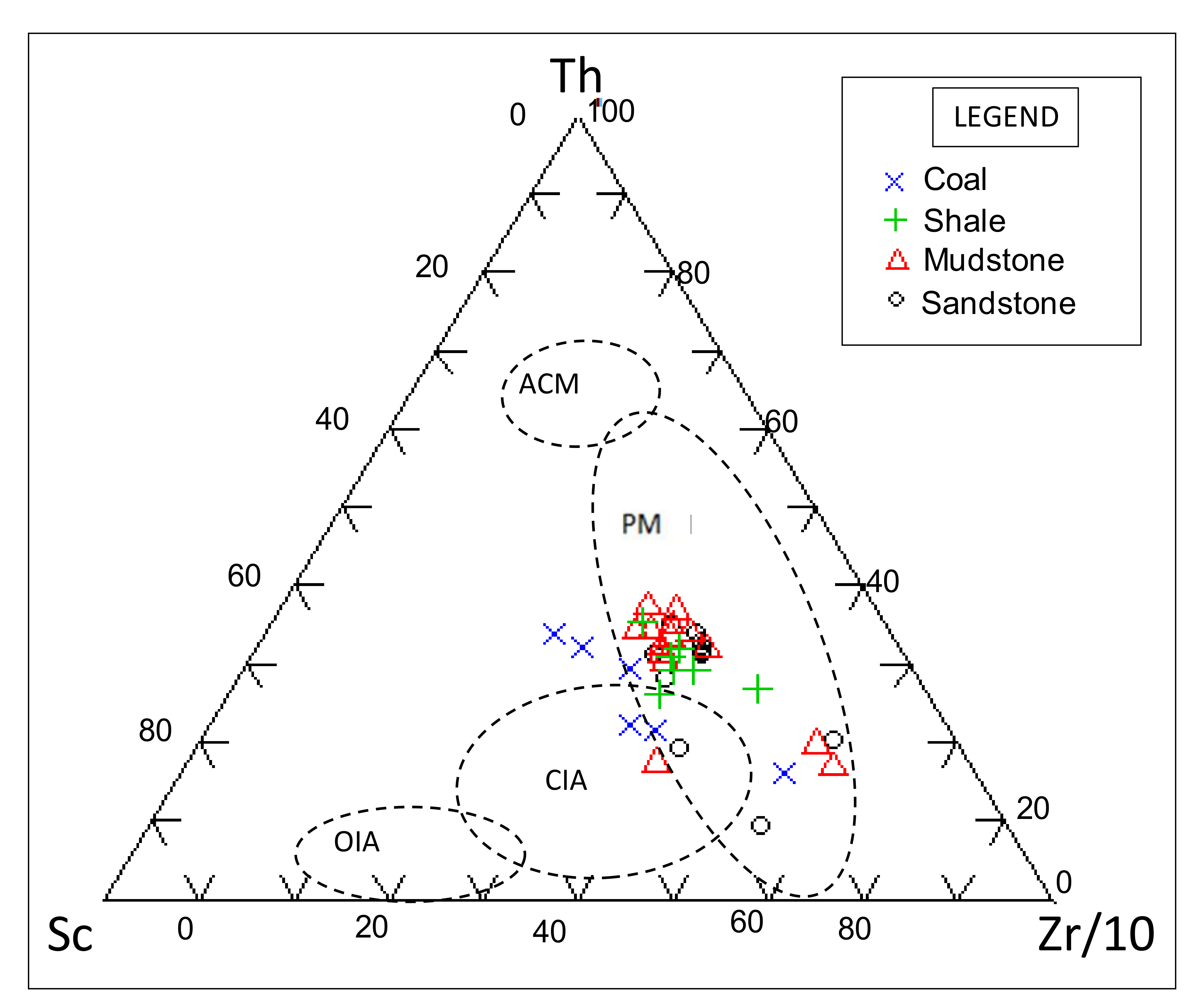
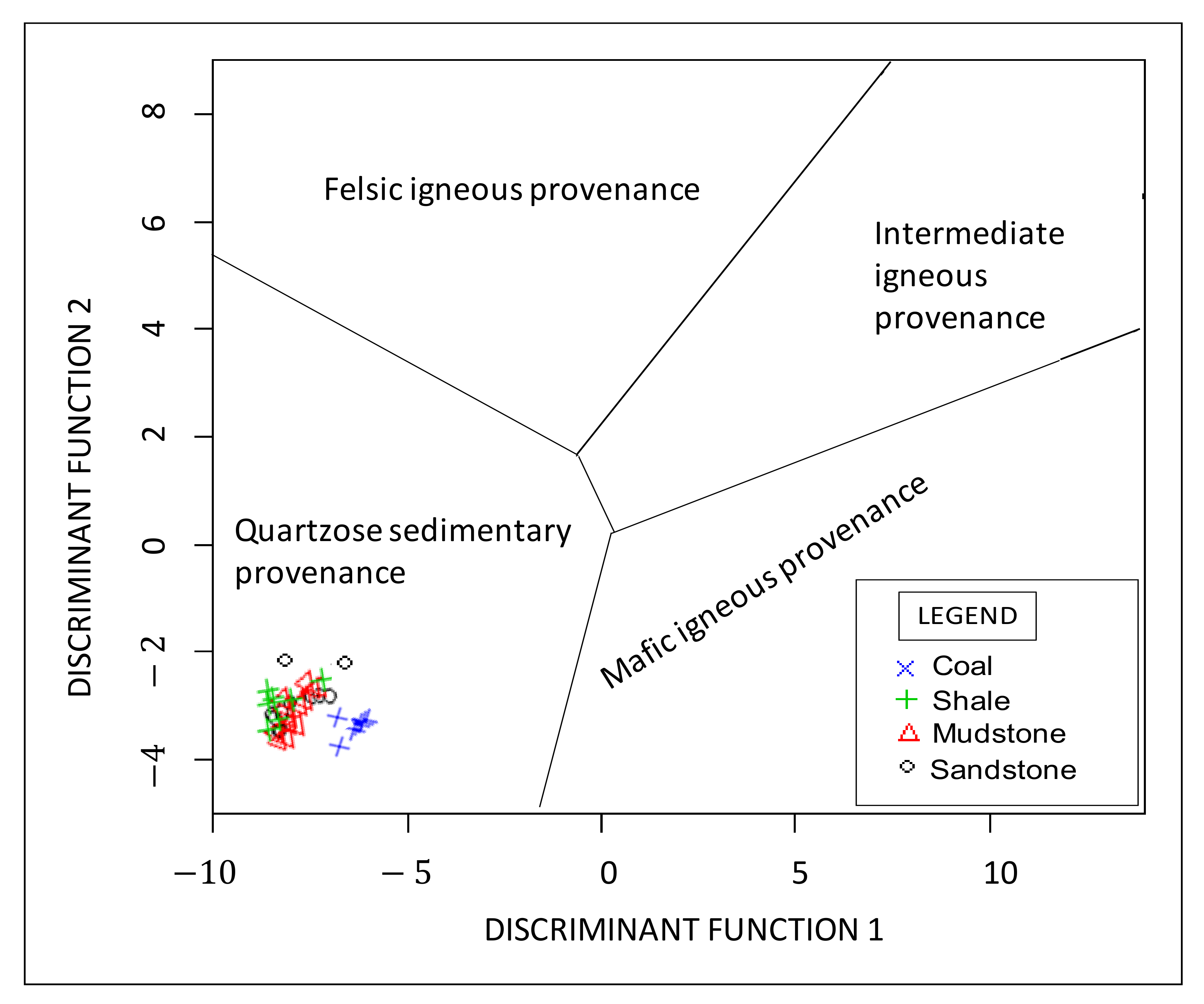
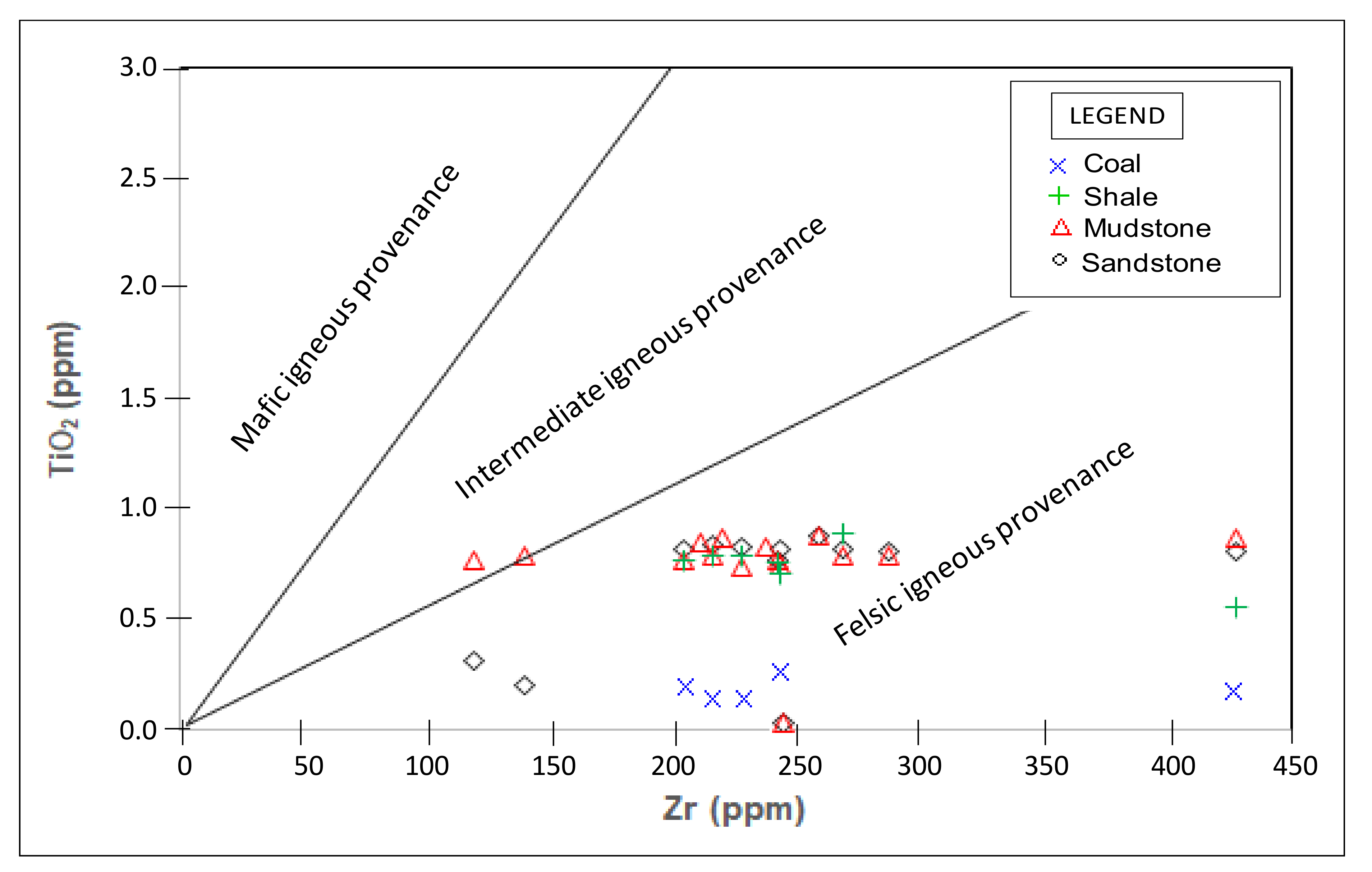
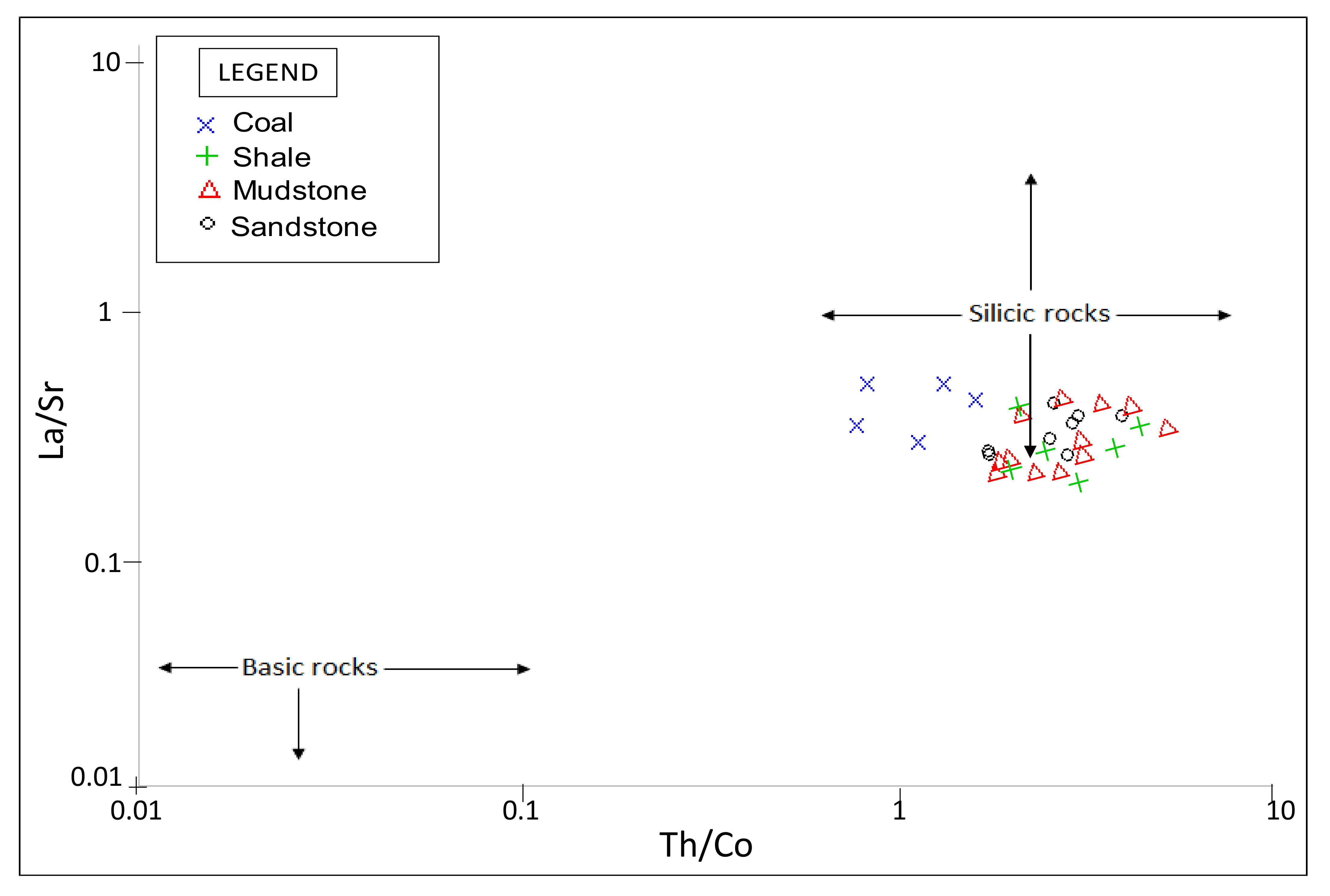
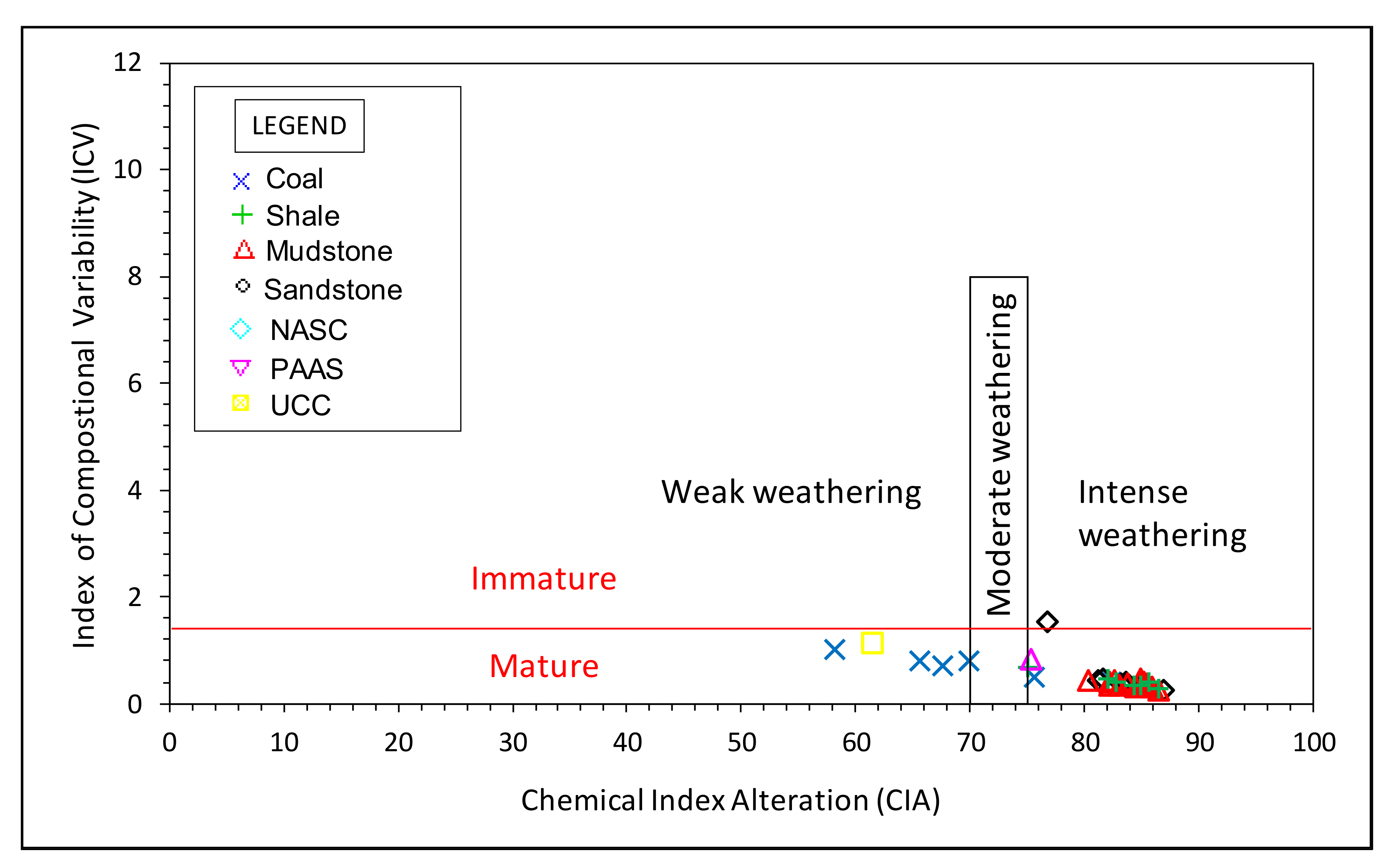
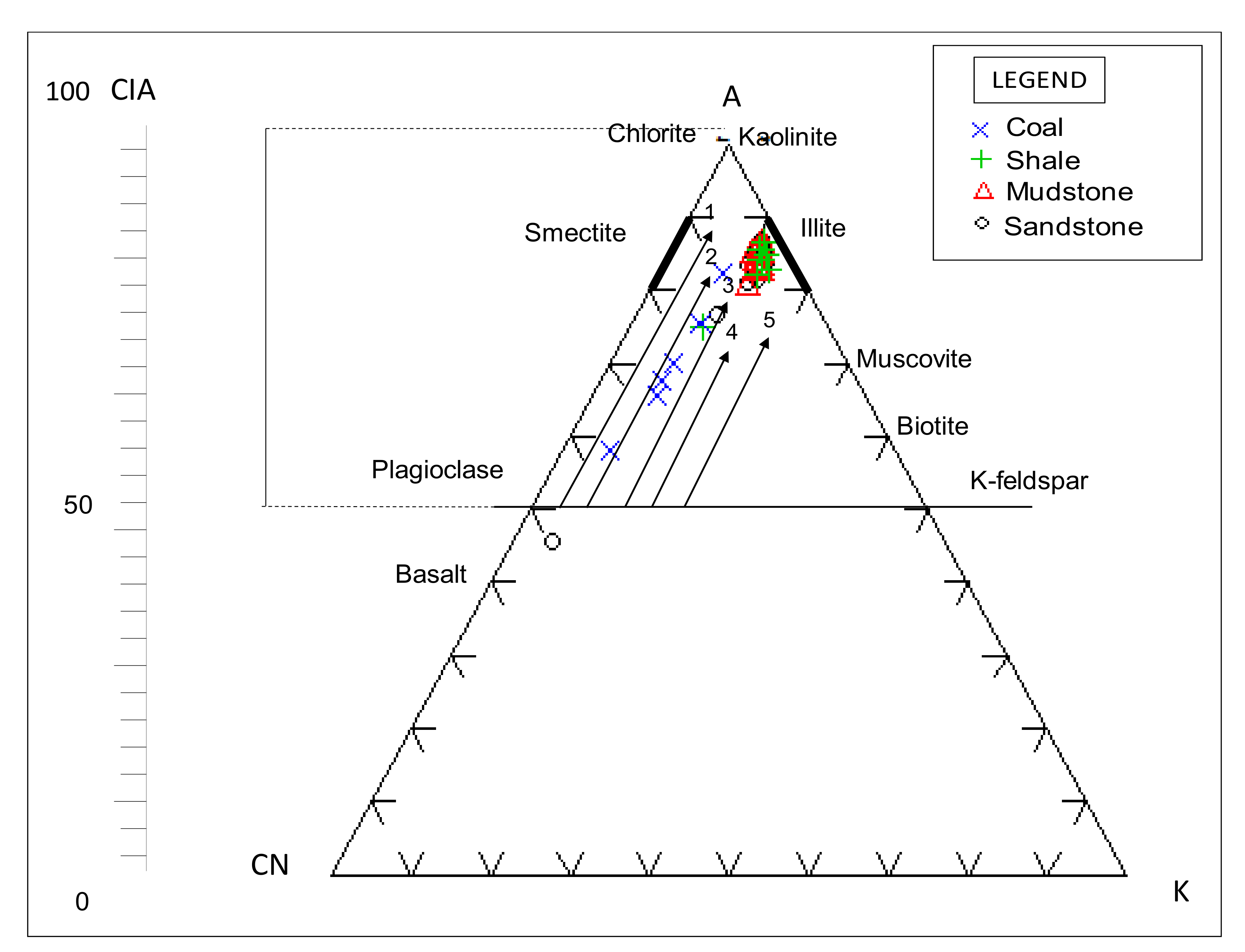
| Borehole | Lithology | Depth (m) | Quartz (wt. %) | Graphite (wt. %) | Pyrite (wt. %) | Muscovite (wt. %) | Kaolinite (wt. %) | K-feldspar (wt. %) | Plagioclase (wt. %) | Dolomite (wt. %) | Siderite (wt. %) | Calcite (wt. %) | Chlorite (wt. %) | Smectite (wt. %) | Illite (wt. %) | Hematite (wt. %) |
|---|---|---|---|---|---|---|---|---|---|---|---|---|---|---|---|---|
| OV1125149 | Mudstone | 21.0 | 36.0 | 0.0 | 7.0 | 0.0 | 17.0 | 6.0 | 2.0 | 1.0 | 0.0 | 11.0 | 3.0 | 1.0 | 15.0 | 1.0 |
| Coal | 34.1 | 7.2 | 30.9 | 1.2 | 0.0 | 53.3 | 1.2 | 0.0 | 0.5 | 2.1 | 0.4 | 0.0 | 0.0 | 0.0 | 1.1 | |
| Mudstone | 35.0 | 37.0 | 0.0 | 8.0 | 1.0 | 10.0 | 7.0 | 3.0 | 0.0 | 0.0 | 13.0 | 1.0 | 1.0 | 16.0 | 3.0 | |
| Sandstone | 36.4 | 47.0 | 0.0 | 14.0 | 0.0 | 12.5 | 8.0 | 1.0 | 0.0 | 0.0 | 9.0 | 0.5 | 0.0 | 8.0 | 0.0 | |
| Shale | 53.0 | 28.0 | 0.0 | 9.0 | 0.0 | 16.0 | 9.0 | 2.0 | 0.0 | 0.0 | 12.0 | 4.0 | 3.0 | 23.0 | 0.0 | |
| Shale | 59.0 | 37.0 | 0.0 | 11.0 | 2.0 | 15.0 | 7.0 | 0.0 | 1.0 | 0.0 | 12.0 | 2.0 | 2.0 | 9.0 | 2.0 | |
| OV1125156 | Mudstone | 19.0 | 33.0 | 0.0 | 16.0 | 1.0 | 8.0 | 8.0 | 1.0 | 0.0 | 0.0 | 25.0 | 3.0 | 2.0 | 4.0 | 2.0 |
| Mudstone | 32.0 | 28.0 | 0.0 | 8.0 | 1.0 | 20.0 | 9.0 | 1.0 | 1.0 | 0.0 | 13.0 | 2.0 | 1.0 | 16.0 | 0.0 | |
| Coal | 42.0 | 6.5 | 33.2 | 3.0 | 0.1 | 49.6 | 1.0 | 0.0 | 0.8 | 2.8 | 2.1 | 0.0 | 0.0 | 0.0 | 1.0 | |
| Sandstone | 44.1 | 39.0 | 0.0 | 14.0 | 1.0 | 19.5 | 7.5 | 1.5 | 0.0 | 0.0 | 8.0 | 0.5 | 1.0 | 8.0 | 0.0 | |
| Mudstone | 46.0 | 43.0 | 0.0 | 5.0 | 0.0 | 10.0 | 6.0 | 1.0 | 2.0 | 0.0 | 10.0 | 0.0 | 1.0 | 22.0 | 0.0 | |
| Mudstone | 47.3 | 37.0 | 0.0 | 2.0 | 2.0 | 21.0 | 6.0 | 1.0 | 0.0 | 0.0 | 12.0 | 0.0 | 0.0 | 18.0 | 0.0 | |
| Coal | 48.0 | 9.0 | 32.0 | 4.0 | 0.0 | 51.0 | 0.0 | 0.0 | 0.6 | 1.4 | 1.6 | 0.0 | 0.0 | 0.5 | 0.0 | |
| Mudstone | 48.6 | 39.0 | 0.0 | 1.0 | 0.0 | 11.0 | 4.0 | 3.0 | 1.0 | 0.0 | 16.0 | 2.0 | 1.0 | 21.0 | 1.0 | |
| Shale | 49.7 | 34.0 | 0.0 | 4.0 | 3.0 | 18.0 | 8.0 | 2.0 | 0.0 | 0.0 | 8.0 | 1.0 | 2.0 | 20.0 | 0.0 | |
| Coal | 50.3 | 5.0 | 27.8 | 1.5 | 0.2 | 54.5 | 2.0 | 0.0 | 3.2 | 3.0 | 1.9 | 0.1 | 0.3 | 0.0 | 0.4 | |
| Shale | 51.0 | 30.0 | 0.0 | 5.0 | 1.0 | 21.0 | 3.5 | 0.5 | 1.0 | 0.0 | 7.0 | 1.0 | 0.0 | 26.0 | 4.0 | |
| Shale | 52.9 | 38.0 | 0.0 | 2.0 | 2.0 | 31.0 | 4.0 | 1.0 | 0.0 | 0.0 | 4.0 | 4.0 | 2.0 | 12.0 | 0.0 | |
| Shale | 57.2 | 41.0 | 0.0 | 1.0 | 0.0 | 24.0 | 3.0 | 1.0 | 1.0 | 0.0 | 13.0 | 2.0 | 0.0 | 13.0 | 1.0 | |
| Mudstone | 59.0 | 40.0 | 0.0 | 1.0 | 0.0 | 14.0 | 8.0 | 2.0 | 0.0 | 0.0 | 11.0 | 3.0 | 3.0 | 17.0 | 1.0 | |
| OV1125160 | Mudstone | 21.0 | 33.0 | 0.0 | 0.0 | 2.0 | 27.0 | 7.0 | 2.0 | 0.0 | 0.0 | 15.0 | 2.0 | 1.0 | 11.0 | 0.0 |
| Coal | 23.5 | 10.1 | 36.4 | 2.9 | 0.0 | 52.8 | 2.1 | 0.0 | 1.7 | 2.6 | 1.8 | 0.3 | 1.0 | 0.4 | 1.2 | |
| Sandstone | 24.8 | 37.0 | 0.0 | 3.0 | 0.0 | 24.0 | 5.0 | 3.0 | 2.0 | 0.0 | 9.0 | 1.0 | 1.0 | 13.0 | 2.0 | |
| Mudstone | 31.9 | 45.0 | 0.0 | 0.0 | 0.0 | 18.0 | 5.0 | 1.0 | 1.0 | 0.0 | 4.0 | 0.0 | 1.0 | 24.0 | 1.0 | |
| Coal | 37.0 | 7.2 | 32.0 | 2.0 | 0.0 | 50.4 | 1.2 | 0.2 | 0.4 | 2.5 | 0.1 | 1.0 | 2.6 | 1.0 | 0.4 | |
| Coal | 40.0 | 9.0 | 34.1 | 0.8 | 0.0 | 49.2 | 1.0 | 0.0 | 0.5 | 3.1 | 0.2 | 0.4 | 1.0 | 0.1 | 0.6 | |
| Mudstone | 41.0 | 30.0 | 0.0 | 2.0 | 1.0 | 19.0 | 8.0 | 1.0 | 1.0 | 0.0 | 13.0 | 2.0 | 1.0 | 22.0 | 0.0 | |
| Mudstone | 42.0 | 37.0 | 0.0 | 4.0 | 0.0 | 15.0 | 2.5 | 0.5 | 1.0 | 0.0 | 20.0 | 1.0 | 0.0 | 16.0 | 3.0 |
| Oxide | Coal | Shale | Mudstone | Sandstone |
|---|---|---|---|---|
| SiO2 (%) | 9.64–24.13 | 62.93–69.48 | 62.52–71.90 | 39.99–65.63 |
| TiO2 (%) | 0.14–0.30 | 0.76–0.87 | 0.75–0.88 | 0.20–0.85 |
| Al2O3 (%) | 3.17–7.20 | 16.45–20.48 | 5.51–19.98 | 3.32–20.00 |
| Fe2O3 (%) | 0.42–2.17 | 1.67–2.87 | 1.07–3.53 | 3.03–29.33 |
| MnO (%) | 0.01–0.02 | 0.01–0.02 | 0.01–0.04 | 0.01–0.02 |
| MgO (%) | 0.17–0.50 | 0.43–0.90 | 0.43–1.16 | 0.16–0.92 |
| CaO (%) | 0.49–2.20 | 0.32–0.75 | 0.26–0.86 | 0.44–3.55 |
| Na2O (%) | 0.03–0.08 | 0.32–0.84 | 0.35–0.60 | 0.05–0.30 |
| K2O (%) | 0.42–0.82 | 2.09–2.62 | 2.15–2.92 | 0.36–0.76 |
| P2O5 (%) | 0.03–0.05 | 0.06–0.13 | 0.04–0.15 | 0.03–0.11 |
| Trace Elements | Coal | Shale | Mudstone | Sandstone | |
|---|---|---|---|---|---|
| LILE | Rb (ppm) | 131–173 | 93–156 | 24–163 | 19–147 |
| Ba (ppm) | 260–761 | 276–324 | 129–513 | 294–377 | |
| Th (ppm) | 20–20 | 10–20 | 2–19 | 2–19 | |
| Sr (ppm) | 98–211 | 140–201 | 60–208 | 90–183 | |
| HFSE | Zr (ppm) | 43–290 | 212–427 | 63–432 | 139–217 |
| Y (ppm) | 5–55 | 24–49 | 5–51 | 21–50 | |
| Nb (ppm) | 20–24 | 15–24 | 4–24 | 3–22 | |
| TTE | Sc (ppm) | 11–17 | 9–15 | 4–16 | 6–15 |
| V (ppm) | 7–108 | 45–84 | 5–99 | 76–86 | |
| Cr (ppm) | 53–105 | 53–108 | 50–243 | 57–340 | |
| Ni (ppm) | 11–70 | 10–16 | 7–50 | 16–101 | |
| Zn | 4–108 | 49–107 | 4–132 | 22–59 | |
Publisher’s Note: MDPI stays neutral with regard to jurisdictional claims in published maps and institutional affiliations. |
© 2021 by the authors. Licensee MDPI, Basel, Switzerland. This article is an open access article distributed under the terms and conditions of the Creative Commons Attribution (CC BY) license (http://creativecommons.org/licenses/by/4.0/).
Share and Cite
Denge, E.; Baiyegunhi, C. Geochemical and Petrographical Characteristics of the Madzaringwe Formation Coal, Mudrocks and Sandstones in the Vele Colliery, Limpopo Province, South Africa: Implications for Tectonic Setting, Provenance and Paleoweathering. Appl. Sci. 2021, 11, 2782. https://doi.org/10.3390/app11062782
Denge E, Baiyegunhi C. Geochemical and Petrographical Characteristics of the Madzaringwe Formation Coal, Mudrocks and Sandstones in the Vele Colliery, Limpopo Province, South Africa: Implications for Tectonic Setting, Provenance and Paleoweathering. Applied Sciences. 2021; 11(6):2782. https://doi.org/10.3390/app11062782
Chicago/Turabian StyleDenge, Elelwani, and Christopher Baiyegunhi. 2021. "Geochemical and Petrographical Characteristics of the Madzaringwe Formation Coal, Mudrocks and Sandstones in the Vele Colliery, Limpopo Province, South Africa: Implications for Tectonic Setting, Provenance and Paleoweathering" Applied Sciences 11, no. 6: 2782. https://doi.org/10.3390/app11062782
APA StyleDenge, E., & Baiyegunhi, C. (2021). Geochemical and Petrographical Characteristics of the Madzaringwe Formation Coal, Mudrocks and Sandstones in the Vele Colliery, Limpopo Province, South Africa: Implications for Tectonic Setting, Provenance and Paleoweathering. Applied Sciences, 11(6), 2782. https://doi.org/10.3390/app11062782






